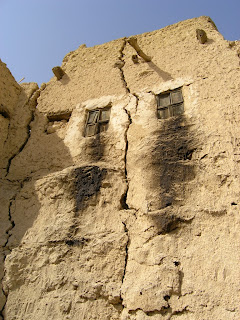Dunes and Jacuzzis – Sunset at the Oasis
 There is a real feeling of being in an old Mediterranean city, Palermo perhaps, and on the first morning we awoke to find RAIN! The marble balcony of the faded and gently melancholic Hotel Triomphe was definitely wet! Feeling righteously vindicated in our decision to carry waterproofs around with us for the past two months of desiccated weather, we donned them and wandered for breakfast of hot chocolate and croissants in the Delice patisserie in the square. Looking out over the wet street at the rickety trams and damp horse drawn carriages gave us a definite pang of euro-homesickness! By the end of breakfast the rain had stopped and we were left with our white-elephant macs.
There is a real feeling of being in an old Mediterranean city, Palermo perhaps, and on the first morning we awoke to find RAIN! The marble balcony of the faded and gently melancholic Hotel Triomphe was definitely wet! Feeling righteously vindicated in our decision to carry waterproofs around with us for the past two months of desiccated weather, we donned them and wandered for breakfast of hot chocolate and croissants in the Delice patisserie in the square. Looking out over the wet street at the rickety trams and damp horse drawn carriages gave us a definite pang of euro-homesickness! By the end of breakfast the rain had stopped and we were left with our white-elephant macs.From Alexandria, a four-hour bus journey took us west along Egypt’s Mediterranean coast to Mersa Matrouh, near the Libyan border, where we turned south for the five-hour journey across the desert to the Qatarri depression and Siwa oasis. This is an amazing place! Only connected to the outside world by road twenty years ago, the Berbers, descended from seven founding families who arrived here in about 1200 and who make up its population, differentiate between themselves –Siwis – and people from the rest of Egypt – Egyptians! A strong clan feeling pervades. Eighteen metres below sea level, Siwa produces the most amazing olive oil, dates and bottled water but has recently started suffering from excess salination, which makes the whole place sparkle, and a rising water table – too much water in the desert! But the amazing crown of this place is the Shali – rising above the centre of the town, this fantasy Gormenghast-like fortified town built of a mixture of mud, salt (crystal and rock) and date palm trunks that sets hard when dry but melts like ice cream in the rain.
 For centuries the gates of the Shalee were closed at night for protection from raiding parties of Bedouin and a strict curfew on humans and animals was observed; no building was allowed outside the walls so the town grew organically up and up, house upon house, to the height of 60m. Eventually, after a few years of unnaturally heavy rainfall and conquest by Mohammed Ali, the Shali was declared unsafe and building was allowed outside its walls – still of the same material – and many of these buildings are still inhabited.
For centuries the gates of the Shalee were closed at night for protection from raiding parties of Bedouin and a strict curfew on humans and animals was observed; no building was allowed outside the walls so the town grew organically up and up, house upon house, to the height of 60m. Eventually, after a few years of unnaturally heavy rainfall and conquest by Mohammed Ali, the Shali was declared unsafe and building was allowed outside its walls – still of the same material – and many of these buildings are still inhabited.



Another wonderful thing about Siwa is the hot springs. Bubbling, sulphurous and of various temperatures, they are blue jewels in the desert, the ultimate jacuzzi in an incredible setting! We splash out on a half-day desert safari, bombing over the dunes in a four-wheel-drive Toyota


The local people, like most Egyptians, are incredibly friendly and enjoy nothing more than a cup of dynamite Siwan tea (very strong, in tiny glasses, like Turkish coffee) and a chat –‘What about Tony Blair?’, ‘Bush and Blair, no good’ – they also, like most other Egyptians, are very politically aware and do not like what is happening in Iraq or in the Middle East in general. We met a lovely Egyptian/Dutch couple on the bus who have spent many, many years visiting Siwa, building strong relationships with locals and bringing their daughters here when they were young, one of whom, has named her son Siwa and now has a place here. We also met some English people – ‘Where are you from?’ we were asked, ‘Hampshire,’ we replied, ‘Nowhere near Liphook, I suppose?’, ‘The very place!’, ‘Well, that’s where my wife is from!’ They are super-enterprising and, having survived the tsunami with their three kids, left their ‘somewhere different’ holidays project there and set up somewhere different in Siwa, winning the trust of Siwans with their respectful approach.
Alas, our Egyptian odyssey is nearly at an end, leaving us just a couple of weeks to make our way back, via Cairo, to Dahab for a last week of diving. Dahab is up the coast from Sharm el Sheikh and used, in the halcyon days, to be a hippy hangout. Nowadays many bemoan the changes that have taken place as Dahab successfully positions itself in the modern gap-year market. There are not many back-packers in Egypt but they nearly all, at some point, end up here. There are a few big-ish resort hotels outside the main town but most of the visitors here want relatively low-key tourism and Dahab provides it.




0 Comments:
Post a Comment
<< Home